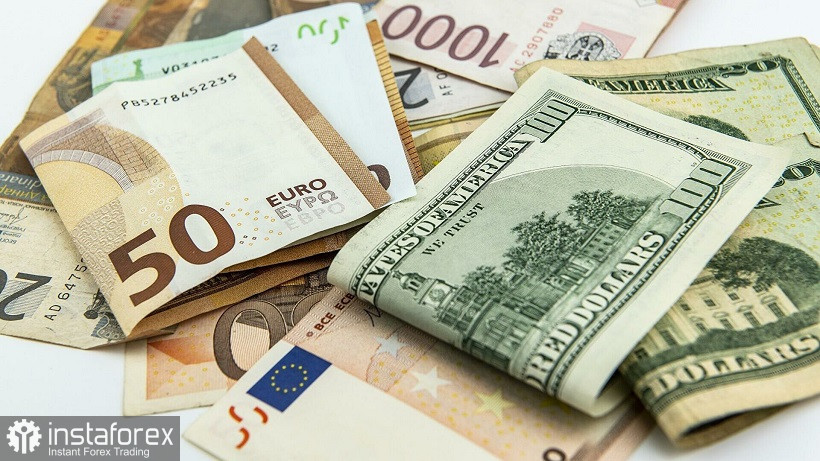EUR/USD is still trading in the range of 1.1530 – 1.1600, i.e. between the lower and the middle lines of Bollinger bands on the daily chart. EUR/USD buyers are trying to push the pair into a correctional move to test the upper border of the mentioned price range. At present, this is a must-do for the bulls that they still cannot do. The bulls are fighting for every pip. They make one stop forward and two steps back. Multiple downward intraday retracements confirm that long positions are not the best idea at the moment. The fundamental picture is also against the euro, but it benefits the US dollar. After a rapid nosedive on Friday, EUR/USD has to make a correctional climb. EUR/USD sellers have not been able to settle below 1.1530. So, the buyers took the lead and now they can afford to make the pair gyrate in a 70-pips trading range up to 1.16.
Looking at the monthly chart, EUR/USD has been developing the downtrend step by step, making pauses. In June, the price sank from 1.2225 to 1.1850. Then the price consolidated for two months until September. During the bearish move, EUR/USD tumbled more than 200 pips from 1.1900 to 1.1664. This time, the currency pair has again got stuck in a wide range which is gradually getting narrower to the lower border. If this dynamic persists, the bears will venture into another breakout. If so, the trading range will shift towards 1.1500 – 1.1430. The Kijun-sen is the lower border of the Kumo cloud on the MN timeframe.

This assumption is not based on technical analysis. The fundamental background encourages a further downtrend of EUR/USD.
The main argument of the dollar bulls is the hawkish Federal Reserve. Although Jerome Powell expressed moderately hawkish rhetoric, rejecting the intentions to raise interest rates in July next year, a lot of voting FOMC members do not rule out this scenario. For example, Vice Chairman Richard Clarida stated that apparently, conditions for the first rate hike would be created by the end of 2022. Besides, he said an interesting phrase. Citing his words, the median Fed's forecast will correspond to the regulator's policy provided that current forecasts of inflation and employment are implemented in practice. Let me remind you of the policy update of the September meeting. Half of 18 FOMC members pointed out that they expected a rate hike until the end of 2022. Another argument for is the recent nonfarm payrolls (all components were upbeat) and rising inflation which is printing multi-year highs.
Today St. Louis Federal Reserve President James Bullard fueled speculations, saying that he expects two rate hikes next year. Another thing is that he admitted that the Federal Reserve would terminate the stimulus program before July. This fact will enable the regulator to begin tightening monetary policy in the summer 2022. Though James Bullard does not vote in the rate-setting committee this year, his remarks should not be neglected. In 2022, he will regain the voting right in 2022 on a rotation basis.
Amid such hawkish stance of the Federal Reserve, the ECB looks polar opposite. The most ECB members state that the regulator will carry on with soft monetary policy despite soaring inflation in the Eurozone. ECB chief economist Philip Lane said that medium-term inflation in the Eurozone remains weak. Besides, he mentioned that disruptions in supply chains and a surge in energy prices bear the major risks for the EU economy. Thus, Mr. Lane again rejected the scenario that QE would be wound up and interest rates would be raised ahead of schedule, i.e. before 2024.
All in all, policy differential between the ECB and the Federal Reserve does not allow the bulls to wreck the downtrend of EUR/USD. So, the ongoing spike should be seen as another correctional climb after a nosedive on Friday. If the price approaches the upper border of the trading range, i.e. 1.600, it would be a good idea to open short positions towards support of 1.1530.To break this price barrier, the bears need a fresh newsworthy event. For instance, US inflation data which is due on Wednesday could be beyond analyst expectations.
From the technical point, EUR/USD is now between the middle and lower lines of Bollinger bands on the daily chart. Ichimoku indicator generated a bearish signal on the same daily chart. This technical picture tells us that market sentiment favors short positions towards the lower border of Bollinger bands that corresponds to the target of 1.1530.
 English
English 
 Русский
Русский Bahasa Indonesia
Bahasa Indonesia Bahasa Malay
Bahasa Malay ไทย
ไทย Español
Español Deutsch
Deutsch Български
Български Français
Français Tiếng Việt
Tiếng Việt 中文
中文 বাংলা
বাংলা हिन्दी
हिन्दी Čeština
Čeština Українська
Українська Română
Română

